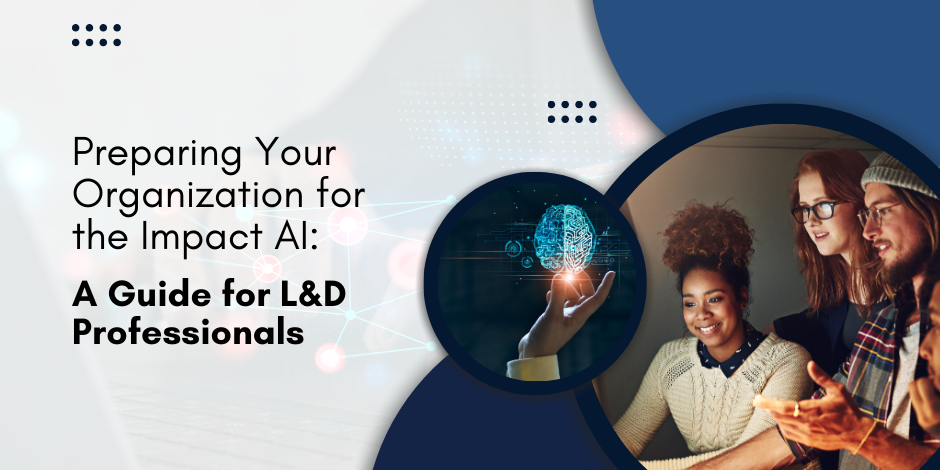Preparing Your Organization for the Impact of AI: A Guide for L&D Professionals

Stay Informed With Our Weekly Newsletter
Receive crucial updates on the ever-evolving landscape of technology and innovation.
As you’re surely aware, in today’s rapidly evolving business landscape, the rise of artificial intelligence (AI) is transforming various industries.
As a learning and development (L&D) professional, it’s crucial to understand the impact of AI and prepare your organisation for its integration.
This guide will provide insights and strategies to navigate the impact of AI on your organization.
Understanding the role of AI in today’s business landscape

AI is revolutionizing how businesses operate and make decisions.
It’s a technology that enables machines to simulate human intelligence and perform tasks precisely and accurately.
The impact of AI and its vast potential is immense, from automating routine tasks to providing valuable insights through data analysis.
With its increasing prevalence, L&D professionals must understand AI’s implications and potential impact on various industries.
But what exactly does the rise and impact of AI mean for businesses?
The rise of AI: What it means for businesses
The rise of AI is reshaping the business landscape by enhancing productivity, efficiency, and innovation.
It offers organizations new opportunities for growth and competitive advantage.
With the mass adoption of ChatGPT, for example, AI has been able to automate repetitive tasks, enabling employees to focus on higher-value work and creativity.
This frees up valuable time for employees to engage in strategic thinking and problem-solving, ultimately driving business success.
However, AI also presents business challenges, such as developing new skills and adapting to changing job roles.
Organizations must stay informed and proactively prepare for AI’s impact to remain competitive in the digital age.
Investing in upskilling and reskilling programs can help employees acquire the necessary knowledge and expertise to work effectively with AI systems.
By embracing AI as a collaborative tool rather than a threat, businesses can harness its potential to drive innovation and growth.
The potential impact of AI on various industries
AI has the potential to revolutionize industries.
In fact, it’s already doing so.
AI can improve diagnosis accuracy, develop personalized treatment plans, and enhance patient care in healthcare.
AI can optimize processes, streamline supply chains, and enable predictive maintenance in manufacturing.
As L&D professionals, it’s crucial to envision AI’s potential impact on your industry and develop strategies to leverage its benefits.
By embracing AI as a transformative force, businesses can navigate the ever-evolving business landscape and thrive in the age of AI.
The importance of L&D in AI integration
As organizations embrace the impact of AI, the role of L&D professionals becomes increasingly critical.
L&D professionals play a fundamental role in facilitating the adoption of AI technologies and ensuring a smooth transition for employees.
By understanding the specific needs of the organization and its workforce, L&D professionals can design and implement effective training programs that give employees the necessary skills to work alongside AI technologies.
Leading organizations recognize the importance of L&D in preparing their workforce for AI integration.
They invest in upskilling and reskilling programs, like those on offer with the Institute of Data, to ensure employees have the skills to thrive in an AI-driven workplace.
The role of L&D professionals in AI adoption
L&D professionals can act as strategic partners in AI adoption by collaborating with stakeholders to identify skill gaps and develop appropriate training solutions.
They can assess the organization’s AI readiness and create a customized learning journey for employees to acquire AI-related skills.
Moreover, L&D professionals can provide ongoing support by staying updated with AI trends and curating relevant learning resources.
This includes partnering with external experts, leveraging online learning platforms, and fostering a culture of continuous learning and development.
Building an AI-ready workforce through L&D
To build an AI-ready workforce, L&D professionals must focus on specific areas.
Firstly, they should provide foundational training on AI concepts and technologies.
This includes understanding machine learning (ML) algorithms, data analytics, and ethical considerations surrounding AI.
Secondly, L&D professionals should support employees in developing the technical skills required to work with AI tools and platforms.
This may involve training in programming languages, data manipulation, and ML model development.
Lastly, L&D professionals should foster a growth mindset and encourage continuous learning among employees.
This can be achieved through creating a supportive learning culture, promoting knowledge sharing, and integrating AI-related learning opportunities into existing programs.
Steps to prepare your organization for AI

Assessing your organization’s AI readiness
Assessing your organization’s readiness before integrating AI into your organization is crucial.
This involves evaluating factors such as the level of AI knowledge and skills in the organization, the availability and quality of data, and the existing infrastructure to support AI implementation.
Conducting a comprehensive assessment will help identify gaps and determine the areas that require attention before AI adoption.
Developing an effective AI strategy
Developing a well-defined AI strategy is essential for successful integration.
L&D professionals should collaborate with key stakeholders to align AI initiatives with organizational goals.
A clear strategy will outline objectives, timelines, resource allocation, and success metrics.
Additionally, it’s vital to consider AI’s ethical and responsible use.
L&D professionals should emphasize the importance of transparency, fairness, and accountability in AI-driven decision-making processes to build trust and mitigate potential risks.
Overcoming challenges in AI adoption
Addressing common fears and misconceptions about AI
AI adoption often raises concerns about job displacement and privacy issues.
L&D professionals must address these fears and provide reassurance to employees.
Communicating the benefits of AI, emphasizing the need for upskilling, and highlighting the potential for new job roles can alleviate concerns and foster a positive attitude toward AI integration.
Ensuring ethical and responsible use of AI
Ethics in AI is a critical consideration for organizations.
L&D professionals should educate employees about the ethical principles relevant to AI, such as fairness, accountability, and transparency.
Incorporating ethical discussions and case studies into training programs can help employees understand the impact of their actions and make responsible choices when working with AI technologies.
Measuring the success of your AI integration

Key performance indicators for AI initiatives
Measuring the impact of AI initiatives is crucial to tracking progress and identifying areas for improvement.
L&D professionals should define key performance indicators (KPIs) that align with organizational objectives.
These may include metrics such as improved productivity, cost savings, increased customer satisfaction, and enhanced employee engagement.
Regularly monitoring and analysing these KPIs will provide insights into the impact of AI integration and enable L&D professionals to make data-driven decisions to optimise AI initiatives.
Continual learning and improvement in the AI era
The impact of AI is constantly evolving. L&D professionals should emphasize the importance of continual learning and improvement to keep pace with technological advancements.
This involves staying updated with the latest AI trends, monitoring industry best practices, and seeking opportunities for professional development.
Encouraging employees towards self-directed learning and providing access to resources, such as online courses and conferences, will facilitate continuous growth and ensure the organization remains at the forefront of AI innovation.
Conclusion
As an L&D professional, preparing your organization for the impact of AI requires a proactive approach.
By understanding AI’s role, recognizing the importance of L&D in AI integration, and following the steps outlined in this guide, you can successfully navigate the challenges and opportunities presented by AI and position your organization for success in the AI-driven future.
Do you want to enrich your organization’s skills and offerings?
Visit the Institute of Data’s Corporate Training Program to learn how our corporate training programs can unlock the keys to your organization’s tech success.
Ready to learn more about our programs? Contact our local team for a free consultation.





